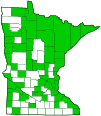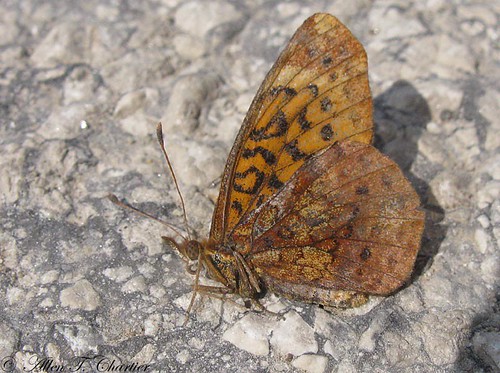meadow fritillary
(Boloria bellona)
Conservation • Description • Habitat • Ecology • Distribution • Taxonomy
|
|
|||||||||||||
Description |
Meadow fritillary is the most common and the most widespread of the lesser fritillaries (genus Boloria). It is a medium-sized brush-foot butterfly, 1⅜″ to 2″ in length with a wingspan of 1¼″ to 2″. The forewing is squared off below the tip, unlike all other fritillaries which have rounded wing tips. The upper sides of both wings are light orange or yellowish-orange with black dots, chain markings, and jagged lines. The eastern subspecies (B. b. bellona), the only subspecies found in Minnesota, is slightly darker brownish-orange toward the base. The western subspecies (B. b. jenastai and B. b. toddi) are darker orangish-brown toward the base and darker overall. There is a postmedial band of round spots, a submarginal band of flattened spots, and a marginal band of small spots. The submarginal spots are distinctly separated, are not chevron-shaped, and do not point inward. The marginal spots are roughly oval, rectangular, or semicircular, and may point outward. There is usually no black marginal line. The underside of the forewing is orange in the basal and medial areas, lighter yellowish-orange in the postmedial area. Black markings mirror the markings on the upper side. The subapical area is mottled orange and brown with a pale purple rectangular spot. The underside of the hindwing is orange near the base and has a pale purplish sheen on the outer half. The purplish sheen may not be apparent on older individuals. There is occasionally a pale purplish spot on the leading edge near the base. Unlike most lesser fritillaries, there are no white or silver spots on the wing undersides. The caterpillar is less than 1″ long. In the early stage it is green and shiny. Mature caterpillars are gray and black. Each abdominal segment has 5 branched, yellowish-brown, spike-like projections (scoli), one on the upper (dorsal) surface, and on each side one in the subdorsal area and one in the spiracular area. Mature caterpillars are found from April to September. |
Size |
Total length: 1⅜″ to 2″ Wingspan: 1¼″ to 2″ |
Similar Species |
Habitat |
Sedge meadows; moist or dry but not wet grassy fields, hay fields, and pastures; roadsides. |
Ecology |
Season |
Two broods: Mid-May to June and July to mid-September |
Behavior |
Males patrol low over grassy areas with a slow, zigzagging flight during the day. |
Life Cycle |
The female lays pale greenish-yellow eggs on twigs or leaves of a plant near, but not on, a host violet. The eggs hatch after about 11 days and the larvae search for and begin feeding on a nearby violet. Third or fourth instar caterpillars overwinter. Males emerge before females. |
Larva Hosts |
Common blue violet (Viola sororia), small white violet (Viola macloskeyi ssp. pallens), and Canadian white violet (Viola canadensis var. rugulosa) |
Adult Food |
Nectar of flowers, mostly those in the Asteraceae family, and especially those with yellow flowers. |
Distribution |
||
|
Sources 7, 21, 24, 27, 29, 30, 71, 75, 82, 83. The range of meadow fritillary has expanded over the last 500 years as land was cleared for for timber and for pastures and hay meadows. Today, the range continues to expand southward from the southeastern states even as it contracts in the northeast. |
|
| 1/15/2025 | ||
Occurrence |
||
Common and widespread |
||
Taxonomy |
|
Order |
|
Superfamily |
Papilionoidea (butterflies) |
Family |
|
Subfamily |
Heliconiinae (fritillaries and longwings) |
Tribe |
|
Subtribe |
Argynnina |
Genus |
Boloria (lesser fritillaries) |
Subgenus |
Clossiana |
Subordinate Taxa |
|
Jenista’s meadow fritillary (Boloria bellona jenastai) meadow fritillary (Boloria bellona bellona) Todd’s meadow fritillary (Boloria bellona toddi) |
|
Synonyms |
|
Clossiana ammiralis Clossiana bellona |
|
Common Names |
|
American meadow fritillary meadow fritillary |
|
Glossary
Scolus
A spiny, branched projection from a larval body wall, the branches terminating with a single stiff, hair-like or bristle-like tip. Plural: scoli.
Spiracle
A small opening on the surface of an insect or arachnid through which it breathes.
Visitor Photos |
||
Share your photo of this insect. |
||
This button not working for you? |
||
Dan W. Andree |
||
Meadow Fritillary... Seen half a dozen or so of these throughout the NWR Northern Tallgrass Prairie Pavia Unit recently. I also noticed driving by that area the other evening they have put some cattle out in it again. It was grazed last season, but looks like again this season. Depending how long they have them in there I'll probably avoid that area as I don't care to go out in there with cows. So will see what goes. Not the best image but it is a meadow feeding on a common blue violet. |
 |
|
Meadow Fritillary on Common Blue Violet... This is from a couple years ago one of a couple meadow fritillary I seen. It was during Spring in Norman Co. I just made this from video I shot of it. Meadow Fritillary are small probably the smallest of the fritillary species I have seen. I seen a couple small variegated but also seen a some variegated that were a bit larger than the meadow. |
 |
|
Some Great Spangled are similar in size to some Regals. I think some female regals are just a little larger than the great spangled. While most male regals are smaller than female regals I have encountered a couple male regals nearly the same size as a good sized female regal but most are smaller. I have mistaken female regals seen in a distance for a monarch and vice versa. However close up they are very different. The saying by some the regal is kinda like a monarch dipped in chocolate. To some maybe, but I don’t see it just both uniquely beautiful in their own ways. Regals are rarer. |
||
MinnesotaSeasons.com Photos |
||
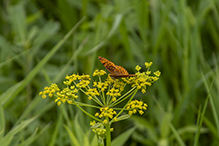 |
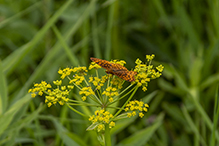 |
|
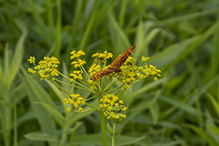 |
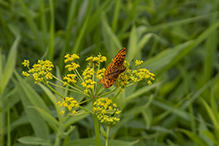 |
|
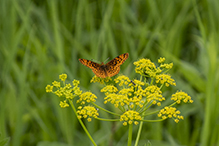 |
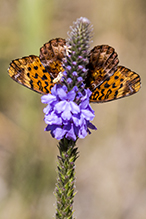 |
|
Underside |

Visitor Videos |
||
Share your video of this insect. |
||
This button not working for you? |
||
Dan W. Andree |
"Fritillary Butterflies" filmed by Dan W. Andree |
About
I filmed some fritillary butterflies during the past years and decided to put together a short video now in 2025 showing 4 different kinds. Just some basic general information and images of the Meadow, Variegated, Great Spangled and Regal Fritillary. There is readable text at the beginning and on and off text and narration throughout the video. |
Other Videos |
||
Butterflies feasting on Connecticut milkweed |
About
Published on Jul 5, 2014 Common milkweed patch attracting Meadow Frittilary (Boloria bellona), Skippers or Duskywings, honey and other varieties of bees, flies and some unique wasps. Video recorded by Dan Haynes. |
Eastern Meadow fritillary Butterfly in the garden |
About
Published on Jul 9, 2015 A gorgeous Eastern Meadow Fritillery Butterfly feeding on Gallardia flower. At the end you can see its tongue sucking up nectar. |
Meadow Fritillary Butterfly |
About
Published on Apr 30, 2013 Eastern Pennsylvania |

Visitor Sightings |
||
Report a sighting of this insect. |
||
This button not working for you? |
||
MinnesotaSeasons.com Sightings |
||

Created: 11/14/2016 Last Updated: © MinnesotaSeasons.com. All rights reserved. |
